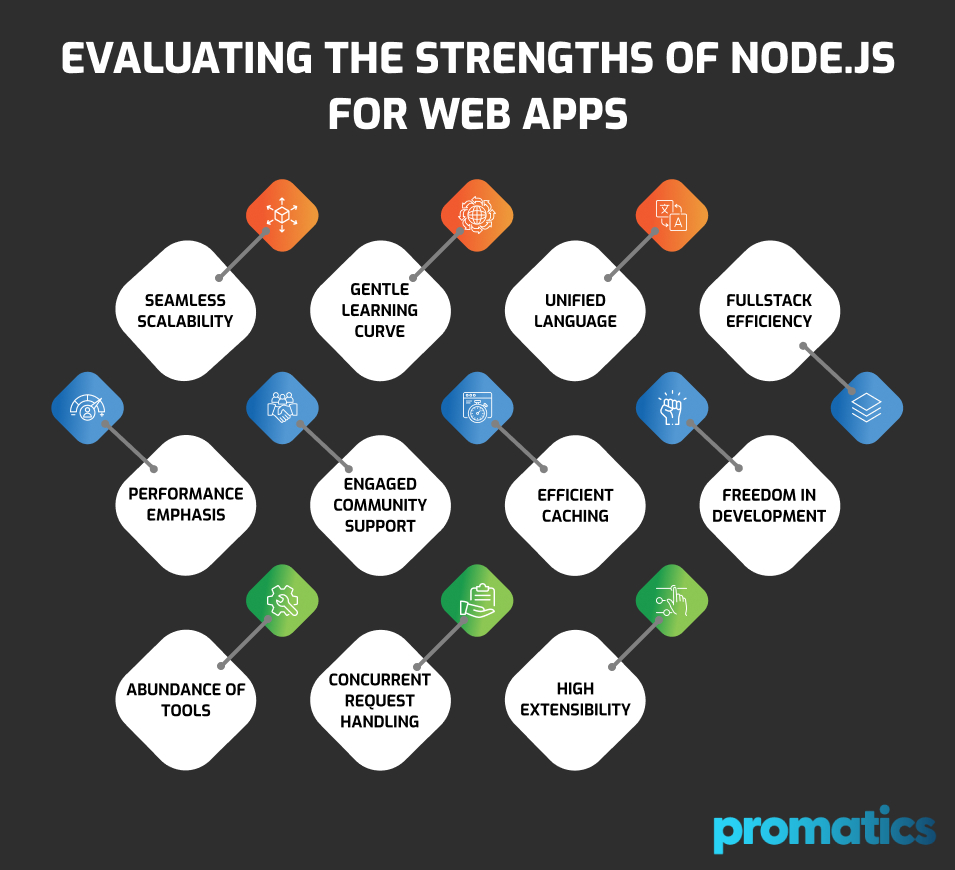The Advantages and Disadvantages of Node.js Web App Development
Table of Contents
Node.js: Unleashing the Power of Server-Side JavaScript
In the dynamic landscape of web development, JavaScript stands tall as one of the most popular and widely used client-side programming languages. Its significance goes beyond just enhancing web front-end experiences; it has evolved into a versatile asset for building cross-platform applications. JavaScript’s reach extends to platforms like React Native, PhoneGap, Titanium, Apache, and NativeScript, redefining the boundaries of its capabilities and utility.
However, JavaScript’s impact has expanded further with its entry into the realm of server-side programming, spearheaded by the revolutionary Node.js. Serving as a runtime environment, Node.js enables the execution of JavaScript code on the server side, ushering in a new era of versatility and innovation. With Google’s V8 JavaScript engine at its core, Node.js equips developers with a suite of features that are poised to reshape server-side programming.
Node.js, at its essence, is an open-source cross-platform technology that empowers developers to build real-time network applications. Its versatility goes beyond traditional web front-end development, as it plays a pivotal role in a multitude of platforms and frameworks. Whether it’s React Native, PhoneGap, Titanium, Apache, or NativeScript, Node.js demonstrates its adaptability and proficiency in traversing diverse technological landscapes.
Powered by the event-driven I/O architecture and asynchronous capabilities, Node.js operates as a runtime environment. The utilization of Google’s V8 JavaScript engine ensures efficient interpretation of JavaScript code, leading to swift and optimized execution. Operating on a single-threaded event-based loop, Node.js offers non-blocking executions, enhancing the performance of applications. It’s important to note that while Node.js serves as a robust runtime environment, it distinguishes itself from traditional frameworks like PHP, .NET, or JAVA, presenting a unique approach to server-side development.
The Advantages of Node.js
Pros of Node.js include the following:
a.) Seamless Scalability
One of Node.js’s primary strengths lies in its capacity to scale applications seamlessly through both horizontal and vertical expansion. The simplicity of adding new nodes for horizontal scaling and enhancing resources for vertical scaling distinguishes Node.js from its counterparts, providing developers with a dynamic and flexible scaling solution.
b.) Gentle Learning Curve:
Given the widespread use of JavaScript in front-end development, transitioning to Node.js for backend tasks is remarkably smooth. The familiarity with JavaScript expedites the learning process, making Node.js an attractive choice for developers.
c.) Unified Language
Node.js streamlines development by enabling the use of JavaScript for both front-end and back-end tasks. This eradicates the need for multiple programming languages and simplifies the deployment of web applications, as virtually all web browsers support JavaScript.
d.) Fullstack Efficiency
Operating as a full-stack JavaScript solution, Node.js empowers developers to build comprehensive applications that encompass both client and server-side components. This consolidation minimizes the need for separate developers, saving time and resources.
e.) Performance Emphasis
Leveraging Google’s V8 engine, Node.js compiles JavaScript code into efficient machine code, resulting in swift execution. The integration of non-blocking I/O operations further bolsters performance and responsiveness.
f.) Engaged Community Support
The Node.js community is expansive and fervently engaged, contributing to continuous improvement and development. This dynamic ecosystem provides developers with readily accessible solutions and code repositories on platforms like GitHub.
g.) Efficient Caching
Node.js incorporates caching of single modules, optimizing web page loading times by minimizing code re-execution.
h.) Freedom in Development
Node.js empowers developers with creative freedom, enabling them to craft applications from scratch without the constraints of rigid frameworks.
i.) Abundance of Tools
Developers working with Node.js have access to a rich toolkit, including Jasmine for testing, npm for dependency management, and Grunt for task automation.
j.) Concurrent Request Handling
Node.js excels in managing concurrent requests through non-blocking I/O systems, ensuring swift and efficient execution of incoming requests.
k.) High Extensibility
Node.js’s extensibility allows developers to customize and expand its functionalities to suit project needs. Built-in APIs for HTTP, TCP, DNS, and more streamline the development process.
In summation, Node.js has revolutionized server-side programming by harnessing the potency of JavaScript, offering an event-driven architecture, asynchronous capabilities, and unwavering developer support. Its adaptability, scalability, and performance optimization position it as a potent tool for contemporary web application development. Whether it’s facilitating real-time applications, managing concurrent requests, or enabling seamless scalability, the advantages of Node.js empowers developers to innovate and elevate their creations, ultimately shaping the future of server-side programming.
Unveiling the Disadvantages of Node.js
As with any technology, Node.js comes with its fair share of drawbacks that warrant a comprehensive discussion to ensure a balanced perspective.
1.) Dynamic API Landscape
One notable challenge developers grapple with is the ever-evolving nature of Node.js’s Application Programming Interface (API). This fluidity is characterized by frequent changes that render the API unstable, leading to potential compatibility issues. The emergence of new APIs with significant backward-incompatible alterations necessitates developers to modify existing codebases to align with the latest version of Node.js’s API. This dynamic environment requires vigilance and adaptability on the part of developers.
2.) Library Limitations
In comparison to other programming languages, JavaScript, the foundation of Node.js, lacks a robust and comprehensive library ecosystem. This deficit becomes evident when attempting to execute tasks like Object-Relational Mapping (ORM), image processing, database operations, and XML parsing. The absence of a well-equipped library system can impede developers, compelling them to rely on common libraries for various functionalities. This limitation makes accomplishing even routine programming tasks within the Node.js environment a potentially challenging endeavor.
3.) Navigating Asynchronous Programming
ode.js places a strong emphasis on the asynchronous programming model, a cornerstone of its scalability. However, transitioning to this model may prove challenging for developers accustomed to the more straightforward linear blocking I/O programming paradigm. Asynchronous programming introduces complexities, with codes potentially becoming convoluted due to nested calls. While this model enhances scalability, developers must navigate its intricacies, often requiring a shift in their programming approach.
These cons of Node.js, though significant, do not undermine the overall strengths and contributions of Node.js. Rather, they highlight areas for improvement and adaptation. The dynamic API landscape underscores the need for diligent monitoring and adaptation to ensure compatibility. While the library limitations pose challenges, they encourage the community to develop innovative solutions to address gaps in the ecosystem. Asynchronous programming’s learning curve reminds developers of the need to embrace evolving paradigms while acknowledging the complexities they introduce.
In the face of these drawbacks, the Node.js community remains resilient and proactive. Developers collaborate to find workarounds, create plugins, and develop best practices that mitigate challenges. The evolving nature of technology requires a dynamic response, and Node.js enthusiasts rise to the occasion by fostering a community of learning, adaptation, and innovation.
It’s important to approach these disadvantages of Node.js with a balanced perspective, recognizing that they are inherent to any evolving technology. By addressing challenges head-on, developers contribute to the growth and enhancement of Node.js, turning limitations into opportunities for improvement. The Node.js journey is marked by continuous refinement, collaborative problem-solving, and the pursuit of excellence in server-side programming.
In Conclusion
Node.js undoubtedly leans in favor of developers when weighed against its drawbacks. Perhaps even more noteworthy is its role in expanding the horizons of JavaScript applications, deftly traversing both frontend and backend domains with equal aplomb.
As the sands of time continue to shift, an increasing number of businesses have embraced Node.js, reaping the rewards of its adoption and witnessing positive transformations.
In the grand tapestry of technology, after taking into account the benefits and drawbacks Node.js emerges as a vibrant thread weaving together the realms of frontend and backend development. Its journey has been marked by its adaptability, forging a path that has captured the attention of both developers and enterprises alike.
As we cast our gaze forward, the impact of Node.js continues to reverberate across the digital landscape, shaping the way we approach JavaScript applications and propelling innovation in uncharted directions.
Frequently Asked Questions
What Exactly is Node.js?
Node.js stands as a dynamic open-source JavaScript runtime environment, orchestrating the execution of JavaScript code beyond the browser’s boundaries.
What are the Pros of Node.js Web App Development?
Node.js unfolds a multitude of advantages for the realm of web app development, including seamless scalability, an approachable learning curve, stellar performance metrics, remarkable extensibility, active community support, and more.
What Cons of Node.js Web App Development Should be Considered?
Despite its commendable strengths, Node.js does harbor certain shortcomings. These include the ever-evolving nature of its Application Programming Interface (API), a relatively modest foundation of library support, and potential elongated development periods due to its asynchronous programming paradigm.
Still have your concerns?
Your concerns are legit, and we know how to deal with them. Hook us up for a discussion, no strings attached, and we will show how we can add value to your operations!

